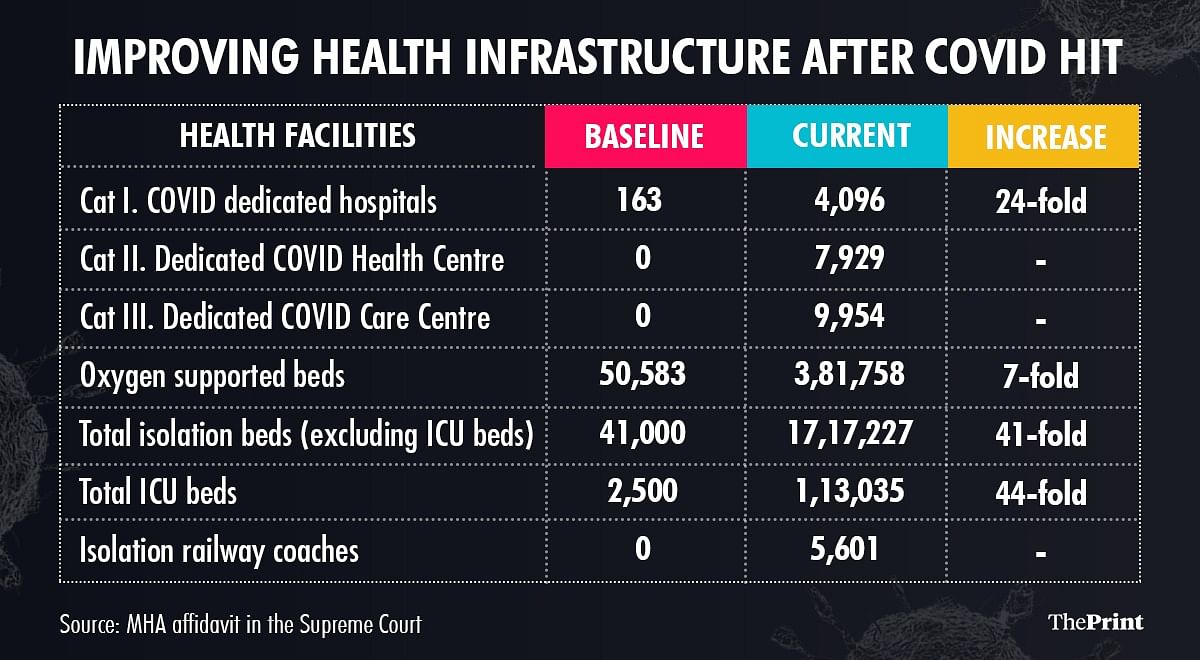Form of words:
New Delhi: The COVID pandemic brought unexpected challenges to India. But it may have somewhat erased the lack of health infrastructure over the years.
Since the first Covid case was reported in the country, there has been an almost seven-fold increase in oxygen beds, 41-fold increase in isolation beds and 44-fold increase in ICU beds, the Ministry of Home Affairs said on Saturday in a Covid death certificate case. Told the Supreme Court in an affidavit.
The apex court was told that there were only 50,583 oxygen supported beds in the country when Covid hit, but at present there are 3,81,758 oxygen beds.

The number of isolation beds has increased from 41,000 to 17,17,227 while the total number of ICU beds has increased from 2,500 to 1,13,035. The affidavit said that earlier there were only 163 Covid dedicated hospitals, now there are 4,096.
There are now 7,929 Category II COVID Health Centers and 9,954 Dedicated COVID Care Centres. These are basically quarantine facilities depending on how sick a person is. None of this was before the pandemic.
India also has 5,601 railway isolation coaches – another addition during the pandemic.
covid care center Proposal Take care of only those cases that are clinically specified as ‘mild’ or ‘very mild’ tagged or ‘COVID suspect’. A dedicated COVID health center is a hospital that takes care of all cases that are clinically assigned as ‘moderate’. Dedicated COVID hospitals primarily provide comprehensive care for those who have been clinically assigned as ‘critical’.
“It is submitted that such support to fight the pandemic situation would include improving the health infrastructure in a short span of time, including large-scale testing, treatment and quarantine facilities on the one hand, and hospitalisation. facilities, which include oxygen beds, ventilators and ICU facilities on the other hand, in which funds are being spent not only from the NDRF but also from the Consolidated Fund of India. It is submitted that this is a sustained effort, which has to be in response to the successive waves of COVID-19 and is being further enhanced,” the government told the court.
It also said that more than 150,000 health workers were engaged during the pandemic. This included 7,024 medical officers, 3,680 specialists, 35,996 staff nurses, 1,01,155 community volunteers, Accredited Social Health Activists (ASHAs) and ASHA assistants, besides 48,453 other support staff.
Read also: Kovid-19 death after 30 days in hospital also eligible for compensation: new guidelines
Poor health spending in the country
India’s chronic low spending on healthcare has been one of the reasons for severe infrastructure limitations in the country.
According to Economic Survey 2020-21India ranks 179th out of 189 countries that prioritize health in its government budget. The limitations of infrastructure also mean that hospitalization rates in India are among the lowest in the world.
“At 3-4 per cent, the hospitalization rate in India is among the lowest in the world; The average is 8-9 per cent for middle-income countries and 13-17 per cent for OECD countries.
National Health Profile 2020, which saw The State of Health Infrastructure in the country, as on 31 December 2019, reported that the country has a total of 8,18,396 hospital beds, but did not give a breakup of oxygen supported and ICU beds in the country.
(Edited by Amit Upadhyay)
Read also: What will the next 6 months of the Kovid epidemic bring?
subscribe our channel youtube And Wire
Why is the news media in crisis and how can you fix it?
India needs independent, unbiased, non-hyphenated and questionable journalism even more as it is facing many crises.
But the news media itself is in trouble. There have been brutal layoffs and pay-cuts. The best of journalism are shrinking, yielding to raw prime-time spectacle.
ThePrint has the best young journalists, columnists and editors to work for it. Smart and thinking people like you will have to pay a price to maintain this quality of journalism. Whether you live in India or abroad, you can Here.